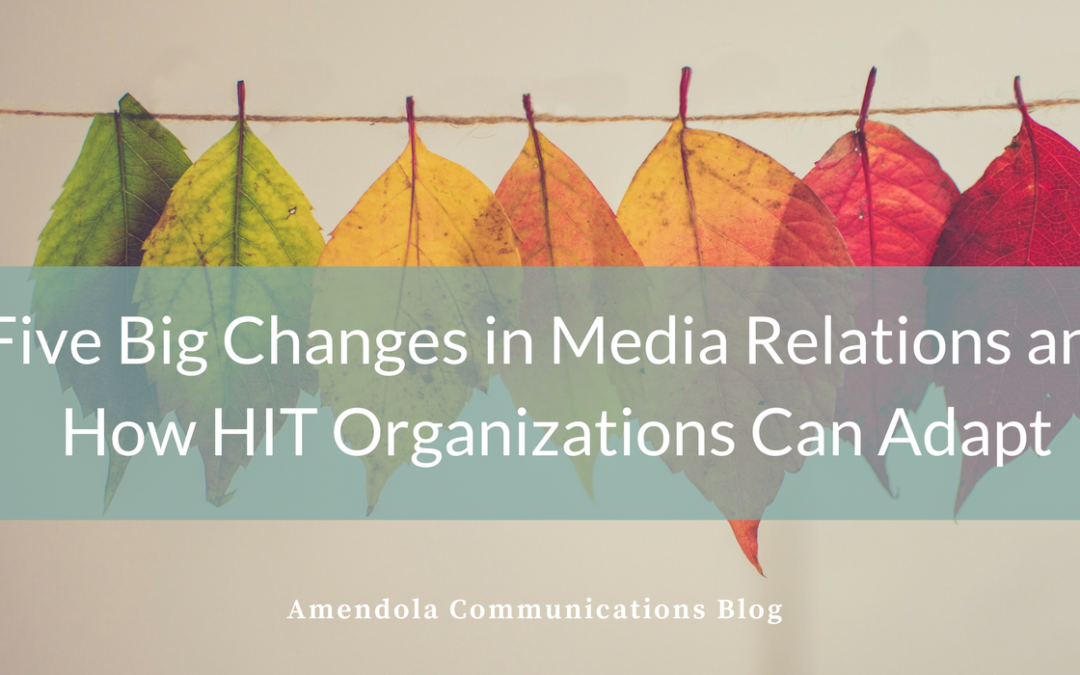by admin | Jun 5, 2018 | News
SCOTTSDALE, Ariz., June 5, 2018 Amendola Communications, a nationally recognized, award-winning healthcare and health IT public relations and marketing agency, is pleased to announce that it has been selected as the PR agency of record for VisitPay.
Amendola will utilize a broad range of public relations and content services to promote VisitPay’s market-leading platform for fully automated patient financial engagement.
Founded in 2010, VisitPay is the developer of a cloud-based platform used by major providers to deliver transparency, choice and control to patients managing healthcare financial transactions and outstanding balances. Through VisitPay, patients can access a complete and comprehensive accounting of their financial obligations, as well as critical health plan and healthcare information, through health system-branded portals.
For health systems, VisitPay’s proprietary analytics tailors consistent and fully compliant financing options to the unique needs of individual patients and their families, creating a simplified billing experience that drives both higher payment rates and improved patient satisfaction scores.
“VisitPay counts some of the largest and most innovative health systems as clients. We wanted a public relations agency that could capitalize on that momentum,” said Will Reilly, Vice President of Marketing at VisitPay. “Amendola’s deep experience in health IT will help us shape and lead the conversation on patient financial experience.”
Amendola will promote VisitPay through a number of public relations and content marketing programs, supported by Amendola’s top-tier media research and relations. The agency will work with VisitPay to increase brand awareness and thought leadership by delivering its core value proposition to target audiences, drawing on its deep industry knowledge and significant media relationships in health IT. Amendola will also be responsible for delivering a range of content demonstrating the thought leadership and expertise of VisitPay’s corporate and client-based leadership.
“Hospitals and health systems are challenged with uncovering the tools and strategies for bringing transparency, choice and control to the patient financial experience,” said Jodi Amendola, CEO of Amendola Communications. “Our collective experience in the patient-as-payer space will be instrumental in helping
About VisitPay
VisitPay is the first and only platform for Patient Financial Health. The culmination of seven years learning and development, this proprietary cloud-based platform enables health systems to dramatically increase the amount paid on patient balances because patients can finally exercise control over their financial health. VisitPay is proudly headquartered in Boise, Idaho, one of the most livable cities in the country, where it has assembled a powerful team focused on predictive analytics, user-driven software design and consumer finance. More information about the company and its solutions can be found at www.visitpay.com.
Media Contact:
Marcia Rhodes
Amendola Communications
mrhodes@acmarketingpr.com
by admin | May 22, 2018 | News
SCOTTSDALE, Ariz., May 22, 2018 Amendola Communications, a nationally recognized, award-winning healthcare and healthcare IT (HIT) public relations and marketing agency, announced today that it has added another accolade from the PR industry. The agency was recently recognized in the overall Healthcare Agency category in Ragan and PR Daily’s Ace Awards 2017.
The Honorable Mention award is just the latest national recognition for the agency, which provides a full range of PR and marketing services, including media and analyst relations, messaging, media training, content development and management, social media, digital and online marketing, collateral development, website design and content creation, crisis management, strategic counsel and other services.
“We have received many awards focused on specific campaigns, but we’re especially proud of this award from Ragan and PR Daily because it recognizes the agency as a whole our work, how we operate, our development of a high-performance team and culture, and the results we generate for clients,” said Jodi Amendola, CEO of Amendola Communications. “We’ve lived and breathed healthcare technology for nearly two decades and, as a result, have developed a team of healthcare veterans with the experience, connections and creativity to drive meaningful business results for businesses of all sizes, whether they’re early-stage startups or established public companies.”
The Ace Awards honor individuals, in-house teams and agencies in communications and marketing. Entrants represent the most talented and innovative thinkers across a variety of industries.
Media Contact:
Marcia Rhodes
Amendola Communications
mrhodes@acmarketingpr.com

by Brandon Glenn | Dec 6, 2017 | Blog
A recent webinar sponsored by Cision explored several changes in media relations over the last few years and offered tips on steps healthcare IT (HIT) organizations should take to prosper in this new reality.
The webinar was led by Michael Smart, a PR pro who says he has trained more than 7,000 communicators in his career, and is based on a white paper he wrote. Smart notes that, in his own observations, he’s seen far too many organizations chase the “Holy Grail” of coverage in the New York Times or Wall Street Journal to the detriment of smaller, lesser-known publications that in some cases could deliver even more value to clients.
Refreshingly, Smart also offered among the sharpest denunciations I’ve come across of the corporate scourge known as multi-tasking, stating, “I hate multitasking. It’s this thing we were all excited about 10 years ago until we realized it’s awful, much like kale. I seriously think it destroys potential and it’s killing a lot of PR pros, and so I’m on a mission to defeat it.”
Amen, though I will admit to enjoying kale in the proper context. To Smart’s comments, I’d like to add my own sarcastic slogan for multitasking, to be emblazoned across inspirational posters hung above the busy cubicles of America: “Multitasking: Why do one thing well when you can simultaneously do 10 things poorly?”
While many of the changes in media relations that Smart describes will be familiar to PR veterans, a refresher never hurts. In that spirit, I attended the hour-long webinar and condensed the five key points down into this quick, bite-sized summary.
- Expand your definition of the “media” in “media relations” to include any third-party trusted by your audiences: In other words, explore nontraditional outlets that may be easier to work with and have similar reach and credibility to the old guard. This can include well-known and widely read sites like Vox that have only been around for a few years, or even corporate blogs. The key is simply whether the site has earned your desired audience’s trust. How do you know which of these sites are worth pursuing? Start by using SimilarWeb to research site traffic and use Moz to examine domain authority.
- Journalists incentives have changed. They must increasingly focus on web traffic: Again, no shocker here for anyone who’s been paying attention. But this new reality opens up new possibilities for HIT organizations. Smart suggests that journalists will be more receptive to your pitches if you can show you’ll be able to distribute their content to a wider audience yourself, ideally by leveraging a social account with a lot of followers or an email newsletter, for example.
- Get noticed before you pitch: All experienced marketers know that journalists will be more receptive to their pitches if they’ve been able to previously establish solid working relationships with those journalists. But Smart offers good advice for establishing those relationships, which are especially important given that there are four PR pros for every professional journalist in the U.S. and U.K., according to statistics he cited during the webinar. He suggests developing a key list of 10 influencers, and then devoting 10 minutes per day to reading content they’ve produced, and when appropriate, reacting to the content with a compliment or a few kind words. He touts this as a simple daily task to “dramatically” increase your response rate. A private Twitter list is a great way to keep up-to-date with content from your top influencers.
- Faux customization often fails: Specific and sincere customization can help you stand out. Smart warns to avoid beginning pitches with broad, non-personalized statements. As supporting evidence for journalists frustration with this approach, Smart cites data from Cision’s 2017 State of the Media Report. When asked to improve the situation, journalists two most frequently cited pieces of advice were, first, to research and understand the media outlets they’re pitching, and second, to tailor their pitches to suit those outlets.
- Journalists don’t have time to do the legwork anymore: Reporters are always on deadline. They don’t have as much time as they once did to research sources or story ideas and they have an “insatiable need for visuals,” which can often be hard to acquire, according to Smart. The big change here is how much of this unglamorous legwork journalists will let HIT organizations do for them once they’ve proven to be trustworthy and credible, Smart says.
No doubt the practice of media relations will continue to change just as quickly as the media ecosystem itself does. But HIT organizations looking to keep pace with this evolution would do well to try implementing some of Smart’s advice. Smarter, more targeted pitching could help free us of our quality-killing, attention-sapping multitasking obsession.

by Philip Anast | Sep 27, 2017 | Blog
As we strive to be better communicators and storytellers, it often helps to get out of our comfort zones and read inspirational literature that can teach us new things. We often find those types of books in classical literature, or from the latest fiction and non-fiction books. Sometimes, “How-to” guides also help.
That happened to me recently when I picked up the book, “A Mind for Numbers: How to Excel at Math and Science (Even if You Flunked Algebra).” You may be asking yourself, “Why would a PR guy be reading a book about math and science?” Isn’t the reason you pursued journalism and then PR in the first place is that you stunk in those other areas?
Well, as it turns out, author Barbara Oakley, Ph.D., did, too. But through a gradual retraining of her brain, she earned a Ph.D. in systems engineering after completing bachelor’s and master’s degrees in Electrical Engineering, and Electrical and Computer Engineering, respectively. She now teaches engineering at Oakland University in Detroit, and is a leading educator in the area of STEM education.
While her book is primarily geared toward helping high school and college students successfully navigate the aforementioned disciplines, it’s ultimately a guide to improving skills and techniques for learning how to learn. And that can be useful for people in any profession, including PR.
Two modes of thinking
For instance, Oakley describes the two modes of thinking: the focused and diffuse.
The focused mode is like the flashlight setting that casts a bright light in a narrow area. It’s a direct approach to solving problems that requires rational, analytic and sequential ways of thinking. When we’re working intently on a project, like writing a white paper or drafting a PR plan/strategy, we use the focused mode of thinking.
But the diffuse mode also plays an important role in those projects. It taps other parts of the brain and is akin to turning your flashlight setting to casting a wider yet less powerful light. As its name suggests, the diffuse mode is wider and big picture. It’s a resting state in our brains. It works quietly in the background and allows us to form new insights. It kicks in when our minds wander, or when we take a break from a focused task to walk, jog, listen to music, sleep or play video games.
Oakley’s point, backed by the hundreds of research studies that inform her book, is that we must maximize both types of thinking to learn and tackle problems.
If we’re working on a specific assignment, it’s important to step away from that work at intervals to allow the diffuse mode to enter the picture. By pursuing a leisure activity or working on some other job assignment, we allow our diffuse mode of thinking to continue working on the first task at hand and lend new insights. The diffuse mode opens up possibilities that we may not have considered in the focused mode and prevents us from believing that only one approach to a project is the single way of accomplishing it.
Taking a better approach
Here are some other practical tips that I gleaned from the book that we can translate to our own profession and help us do our jobs better:
- Avoid procrastination because it prevents the diffuse mode from helping a project or media campaign. While the luxury of time is not always possible in our profession, especially in crisis communication situations, building a timetable of assignments and deadlines, with thoughtful consideration, can help improve the overall response and results.
- Don’t cram to memorize a speech or the big PR plan presentation in one day. Rehearse and study over a series of days and/or weeks. Research shows that we retain the material better, avoid reading the screen verbatim, and make more genuine presentations.
- Avoid reading literature or meeting notes over and over again to learn the material. Instead, use a technique called “pause and recall,” i.e., turn away from the literature and notes after each page or several pages, and describe the concept in one’s own words; that’s the way we build chunks that form strong neural connections in long-term memory.
- Take a 21-minute nap to refresh the brain (but don’t tell the boss). The brain’s neural networks need to be reset from time-to-time, which freshens our outlooks toward problem-solving
- “Lady Luck favors those who try.” Sometimes, we feel downtrodden if a media pitch fails to elicit that desired interview, for example. Perhaps it’s time to let the diffuse mode help; alternatively, we could pick up the phone, be persistent (within reason), and converse with that target reporter directly. In my experience, with professionalism and respect for the journalist on the other end, the odds are good.
As in any learning endeavor, Dr. Oakley’s observation rings true: “The better I got (at math), the more I enjoyed what I was doing. And the more I enjoyed what I was doing, the more time I spent on it.”

by Heather Caouette | Jul 12, 2017 | Blog
Summer conjures many images that are symbolic of a slower pace relaxing by the beach, sipping lemonade by the pool or reading a book under the shade of a tree. These relaxing pictures of a simpler time rarely include your marketing efforts, although they can fall into this summer haze if you don’t take steps to keep them amped up and the drum beat cadence strong.
New customer wins, moving into an expanded headquarters and launching innovative products are obvious reasons to keep your name in the public eye; however, summer seems to have a way with slowing down major events such as these. How do you stay in front of your main audiences without appearing overly promotional?
Conduct Surveys Can you survey your customers to discover a new point of view? Do you have access to de-identified data within your product that could point to an industry trend? One example would be discovering which state’s residents are more likely to take their medication as prescribed than in any other state. Facts and figures are generally well-received and can support your company’s position. These results can be used for a press release, infographic, social media and media relations outreach.
Create a Campaign Develop videos, blog posts or other content addressing problems that your product solves and position yourself as a thought leader. Champion a cause or highlight a struggle like Healthsparq’s #WhatTheHealthcare and athenahealth’s #LetDoctorsBeDoctors campaigns. Branch out as a mover and a shaker to help fix a problem even if your product alone won’t do the trick. Doing this shows you as a trusted ally and advocate.
Offer a Fresh Perspective Your company has knowledge and a viewpoint that is unique. Does your CEO have a fresh position on leadership? What insights can you bring on the industry? Refine that information and share it through media relations, webinars and bylines. Reporters are looking for new ideas that shed light on a relevant topic in a vendor-neutral manner.
Whether done on your own, with a customer or through partnering with a publication, webinars are a great avenue to harness your knowledge about a topic and share it in a way that gives a personal connection. Attendees can get a taste of your personality, in addition to knowledge on the topic, and the chance to ask questions depending on how the session is structured. Contributing articles to publications is also a great way to extend thought leadership by sharing your perspective in your voice.
Support a Charity There are many great causes. Perhaps your company already supports a charity, which would benefit from an event or donation. Another option is to find an organization that allows personal involvement, such as sponsoring a build day with a Habitat for Humanity site near your office. Not only will it be a great team-building exercise, you could get some local press for your efforts. Employees and customers enjoy working with socially responsible companies, so it is a win from all sides.
Everyone hits a slow news cycle at some point. Use this time to refine your position, create a conversation and support a great cause. Each of these methods will extend your brand and deliver more content, including for your social channels.


